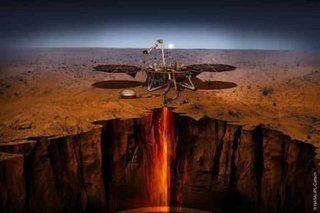Data from two meteorite impacts on Mars recorded by NASA’s InSight spacecraft provide new insights into the structure of the Martian crust. Previously, researchers had observed many quakes whose waves spread from the epicentre of a quake through the interior of the planet. Since then, they had been hoping for an event that would also generate waves traveling along the planet’s surface. On 24 December 2021, the time had come: a meteorite impact on Mars at a distance of about 3500 kilometres from InSight created a crater more than 100 metres in diameter, generating the coveted surface waves. The researchers also identified a meteorite impact at a distance of just under 7500 kilometres from InSight as the source of a second shock. Dr Brigitte Knapmeyer-Endrun and Sebastian Carrasco at the University of Cologne’s Institute of Geology and Meteorology were involved in the assessment of the data these two events provided. The results have now appeared in Science.
Surface waves are important for researchers because they provide information about the structure of the Martian crust. The bodywaves that travel through the planet’s interior during quakes have so far already provided insights into the Martian core, mantle and crust. However, the crust is where the greatest heterogeneity is expected, as on Earth, and the data collected so far have been for only one location on the planet. ‘Until now, our knowledge of the Martian crust was based on only one point measurement under the InSight lander,’ said Dr Doyeon Kim, Oberassistent at ETH Zurich’s Institute of Geophysics and lead author of the study.
The result of the surface wave analysis surprised the geophysicist: between the impact sites and InSight’s seismometer, the Martian crust has, on average, a very uniform structure and a high density. Directly beneath the lander, on the other hand, the researchers had previously detected three layers of crust and measured a lower density. Notably, there was no evidence of the near-surface layer, which is about 10 km thick under InSight and characterized by low seismic velocities and low density, in the new data.
Because the impacts left very distinct craters that can be seen in photos taken from orbit, this is the first time that researchers have been able to accurately determine that seismic data collected by InSight came from distant impacts. Photos taken in rapid succession from the orbit also provided good temporal constraints on when the craters were formed. This precisely matches the times at which the seismic signals were recorded.
This study for the first time employed these different methods (seismic and photographic) to documents impacts that did not occur on Earth. Since meteorite impacts occur at the planet’s surface, this could explain why no surface waves have yet been observed. Sources of seismic waves such as marsquakes, which occur at greater depths, might simply not have excited those waves. Knowing that specific seismic events are impacts will help researchers to better identify and classify meteorite impacts in the data collected by InSight, and to use them for models.
‘The new findings are so interesting because a planet’s crust provides important clues about the formation and evolution of the celestial body. It is the result of early dynamic processes in the mantle and subsequent magmatic processes,’ explained Dr Brigitte Knapmeyer-Endrun. ‘Therefore, it can provide information about conditions billions of years ago and the history of impacts, which were particularly frequent in the early days of Mars.’
The speed at which surface waves spread depends on their frequency. Measuring how the velocity changes across different frequencies in the seismic data allows scientists to infer how the velocity changes with depth, because lower frequencies are sensitive to greater depths. This, in turn, can be used to estimate the average density of the rock, because seismic velocity also depends on the elastic properties of the material through which the waves travel. This allowed the researchers to determine the structure of the crust at a depth of about 5 to 30 kilometres below the planet’s surface.
The team wanted to understand why the average speed of the observed surface waves was considerably higher than they would have expected based on the earlier point measurement under the InSight lander. Is it due to a difference in the surface rock composition or other mechanisms? Volcanic rocks tend to have higher seismic velocities, and the paths between the two meteorite impacts and the measurement site pass through one of the largest volcanic regions in the northern hemisphere of Mars.
Various mechanisms – such as the formation of surface lava or the closure of pore spaces by heating associated with volcanic processes – may increase the velocity of seismic waves. ‘On the other hand, the structure of the crust beneath the InSight landing site may have formed in a unique way, like when material was ejected during a large asteroid impact more than three billion years ago. If so, the structure beneath the lander is probably not representative of the general crustal structure of Mars,’ explained Kim.
Media Contact:
Dr Brigitte Knapmeyer-Endrun
Institute of Geology and Mineralogy
+49 221 470 7130
brigitte.knapmeyer-endrununi-koeln.de
Press and Communications Team:
Jan Voelkel
+49 221 470 2356
j.voelkelverw.uni-koeln.de
Publication:
https://www.science.org/doi/10.1126/science.abq7157
Inhaltlicher Kontakt:
Dr. Brigitte Knapmeyer-Endrun
Institut für Geologie und Mineralogie
+49 221 470 7130
brigitte.knapmeyer-endrununi-koeln.de
Presse und Kommunikation:
Jan Voelkel
+49 221 470-2356
j.voelkelverw.uni-koeln.de
Zur Publikation:
https://www.science.org/doi/10.1126/science.abq7157
